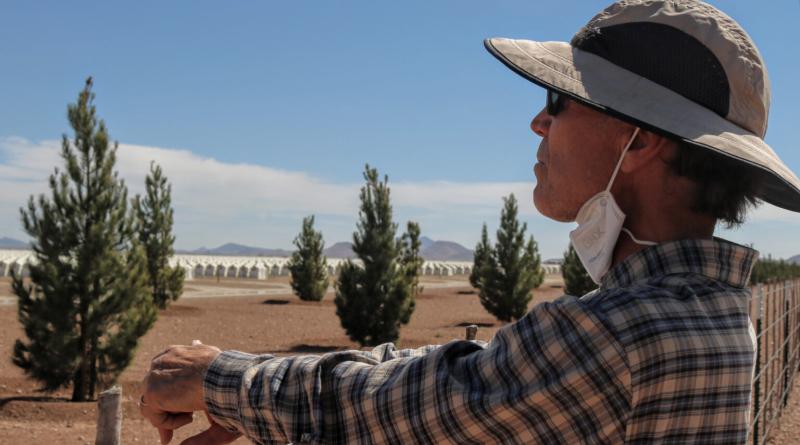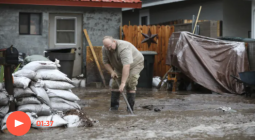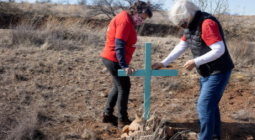Rural Arizona Has Gone Decades Without Groundwater Regulations. That Could Soon Change

It’s been nearly a decade since Steven Kisiel’s well at his home in Wilcox, Arizona, ran dry.
In the years since, his neighbors—along with other rural Arizonans across the state—have encountered the same sight he did when turning on their water facets: a slow trickle of water accompanied by fine sediment, a sign the well is beginning to fail. The cost to reach more water can run tens of thousands of dollars—Kisiel spent nearly $20,000 to redrill his well to access water deeper underground. All the while, massive agricultural operations continue to flood into the state and pump huge amounts of water from underground aquifers.
In Wilcox, east of Tucson, Kisiel watched as more and more enormous farming and dairy operations opened up, resulting in over 90 percent of the local basin’s water going to agriculture, something rural Arizonans have witnessed up and down the state.
The reason for the draining of the aquifers is simple—80 percent of Arizona has no regulations over the use of groundwater. It’s the only state in the Colorado River Basin with such lax rules. In more developed areas, such as Phoenix and its suburbs, groundwater is strictly regulated, with aquifers managed to prevent too much water that can’t be replenished by rain and surface water from being pumped out each year. But in rural stretches of Arizona where agriculture thrives—and takes up most of the state’s water supply—there are no rules even to require monitoring of groundwater pumping.
For years, Arizona legislators have endeavored to enact legislation to change the regulation of rural groundwater use, but their efforts have always failed. As the state’s water woes continued at the start of this year—with more cutbacks to the state’s supply from the Colorado River, a community cut off from water by neighboring Scottsdale due to drought and an announcement that the Phoenix area had officially tapped out its groundwater—new Governor Katie Hobbs, a Democrat, vowed to update Arizona’s water laws and formed a bipartisan Water Policy Council to try again.
Late last month, the water council finally released its policy recommendations, which range from closing a loophole in state law that allowed developers to build homes in urban areas without assuring their water supply, to requiring build-to-rent homes also obtain water certificates in places like the Phoenix metropolitan area. Most controversially, the council provided a framework for implementing regulations over rural groundwater. “I am pleased that the Council has risen to the task, and in six short months of hard work, compromise, and dedication we have a set of recommendations designed to increase water security and ensure continued economic growth in urban and rural Arizona,” Hobbs said in a press release announcing the recommendations.
Now, after decades of failure, rural leaders, water experts and environmentalists are optimistic change may finally be coming to the state’s groundwater laws.
“Until your well goes dry, it’s an easy thing to put on the back burner,” said Kisiel, the Wilcox resident, who has advocated for years to get new groundwater regulations for his community before more wells begin to run dry.
Arizona Is at a Crossroads Over Water Policy
In the most populated parts of the state, the 1980 Groundwater Management Act created Active Management Areas to achieve sustainable yields from aquifers those areas depend on, meaning no more water could be pumped out than flowed in. Under the law, water in the five AMAs is monitored and all new developments need to have the water department certify that it has enough water for 100 years, though some exemptions exist.
That’s allowed the state to pause new groundwater pumping when data from the state water department shows it’s been overallocated, which happened this summer in the Phoenix AMA after the state released a report showing the aquifers beneath the Phoenix metro area could not support any new development of groundwater wells that had not already been approved. New developments without an assured water supply would need to find their water somewhere other than the aquifer.
But such regulation doesn’t exist in rural Arizona outside of a few more recently created AMAs, such as one Douglas voters created last year. Neighboring Wilcox also tried to get voters to approve an AMA but failed. In some rural parts of the state, Irrigation Non-Expansion Areas (INAs) require groundwater pumping be reported and carry restrictions on the development of new users of irrigated water, like farms.
“We really are at a crossroads when it comes to water certainty and water security for all Arizonans,” said Christopher Kuzdas, senior water program manager at the Environmental Defense Fund, who serves on the governor’s water council.
On the one hand, he said, the state can keep the status quo, allowing groundwater usage to go unchecked, leading more and more wells to run dry in rural Arizona. Or it can enact new legislation to address the issue for the first time in 40 years.
The council’s recommendation, echoing years of similar proposed legislation, would establish a third way to regulate water in rural groundwater basins.
Under this new framework, the state would have a more flexible and less stringent way to protect rural groundwater that it could apply itself, or allow residents to initiate through a vote by the county board of supervisors or a petition.
The state water department would then conduct a review to establish the condition of the basin and determine whether it’s truly at risk. If it is, new groundwater expansion would be paused while the water department and local community work to establish goals for the aquifer and a management plan to achieve them. Each basin would have its own rules and regulations, which supporters say is key to maintaining local control over the process and winning the support of rural residents who oppose state mandates.
Key to the proposal, supporters say, is that it would keep control in rural communities and only establish stricter regulations in basins that are experiencing significant overconsumption problems, and not just enact new statewide regulations, even in areas that don’t have overdrawn aquifers.
Opposition Already Building
But for now, the fate of the water council’s recommendations rest with next year’s Arizona Legislative session. The holders of key votes, like the chairwomen of the Natural Resources, Energy and Water Committee—who has for years prevented similar bills from making it to the floor—have signaled they would oppose any legislation based on the council’s recommendation.
That legislator, Rep. Gail Griffin, a Republican, did not respond to a request for comment, but in the weeks before the council released its recommendations, she wrote in the Arizona Capitol Times that all groundwater bills that have been proposed have been “bad” and that “the actual provisions are far from local or voluntary.”
“Instead of reducing the size of government, these bills would create new layers of government and give additional taxing, zoning, planning, and condemnation authority to a small group of unelected, unaccountable bureaucrats to decide the community’s economy and tell you what you can and cannot do with your private property,” she wrote in the op-ed.
She’s not the only one in opposition. Arizona Farms Bureau Association President Stefanie Smallhouse and Republican state Senator Sine Kerr, a dairy farmer from Buckeye who chairs the Senate natural resources committee, were initially part of the groundwater council, but quit in October in protest of efforts to implement more state control of water and concerns that the proposals would leave rural Arizonans’ opinions out of the conversation.
But many rural Arizonans—from city leaders to county supervisors, state representatives and local residents—aren’t opposed, having pushed for reform for years as the local aquifers they rely on diminish.
“Something at some point needs to be done to protect the rural communities,” said Holly Irwin, a supervisor in La Paz County, situated along the Arizona-California border, who has advocated for rural groundwater protection for years. “Not just for my future or for my kids’ future, but for their kids’ future.”
Unlike other industries, agriculture gets a free pass to open up water-dependent operations even in communities where it may not be wanted, said Mohave County Supervisor Travis Lingenfelter, another leader in rural Arizona advocating for more groundwater regulations. His county, home to Kingman in Northeast Arizona along the Nevada border, has also seen an influx of agricultural operations move into the region from California and the Middle East as those regions have experienced water shortages as well.
Under Arizona’s status, agricultural operations on tracts of five or more acres cannot be regulated in any way by a local government (the statute also applies to railroad, mining, metallurgical and grazing operations). All the operation has to do is notify them.
“You couple that with the fact that it’s the ‘wild, wild West’ out here and you can drill as many wells as you want, as large as you want, pump as much water as you want and you don’t have to report it to anybody,” Lingenfelter said. “You know, from a business perspective, you’re basically inviting a future public health crisis around water.”
Mohave County, he said, has been able to turn away water-intensive businesses other than agriculture because places like Kingman, the county seat, only have groundwater to rely on.
The Arizona Department of Water Resources this month began to roll out a series of supply and demand studies of rural groundwater basins. The reports released so far show many of the basins are already in overdraft, meaning more water is being pumped out than is replenished by rain and surface water each year, with those supporting robust agricultural operations in by far the worst shape.
In Wilcox, for example, it found water levels are below the average well depth, with the basin seeing a deficit of 108,428 acre feet in 2022, about the same amount of water Tucson uses each year. Nearly all of that water is used by agriculture.
For Irwin, one of the biggest issues is that little data exists on the state of the aquifers in the county, leaving leaders and residents alike in the dark over just how much is being taken out and what the region can sustain. Her county has yet to have a serious assessment done on the state of its aquifers.
Despite the lack of data, there are still clues to the condition of the aquifer, with residential wells going dry and agriculture operations dotting La Paz County. Massive farms have made international headlines in recent years, namely for a Saudi-owned operation growing alfalfa for cattle on state land and no oversight of the amount of water being pumped for the water-intensive crop. The state recently announced it would cancel its lease to the company, Fondomonte, but big agriculture operations persist in the county.
Those headlines, rural leaders and water experts said, have made the issue impossible to ignore as it threatens the state’s economic development. The question now is whether change will finally come to rural Arizona.
“We’ve known that having no groundwater management whatsoever across the state was a problem for a long time,” Kuzdas said. “Communities have been pleading for solutions, very, very publicly for years. It’s time to get something done.”





